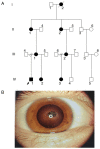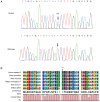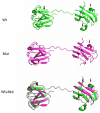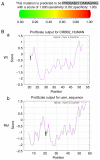Whole-exome sequencing identification of a recurrent CRYBB2 variant in a four-generation Chinese family with congenital nuclear cataracts
- PMID: 34650623
- PMCID: PMC8506933
- DOI: 10.3892/etm.2021.10810
Whole-exome sequencing identification of a recurrent CRYBB2 variant in a four-generation Chinese family with congenital nuclear cataracts
Abstract
Congenital cataracts is the most common cause of visual impairment and blindness in children. Although there have been extensive studies into the pathogenesis of congenital cataracts, the pathogenic mechanism underlying the recurrent variant CRYBB2:c.62T>A(p.I21N) has not been previously reported. Thus, the present study aimed to use whole-exome sequencing (WES) to identify potential genetic variants and investigate how they may have induced the occurrence of cataracts in a four-generation Chinese family with congenital nuclear cataracts. The medical history of this family was recorded and WES was conducted for one proband. Sanger sequencing was used to verify the presence of the putative variant in all participants. PolyPhen-2, SIFT and ProtScale were used to analyze the effect of the identified variants on protein function and hydrophobicity, and Pymol was used to show the structure of the wild-type (Wt) and mutant β-crystallin B2 (CRYBB2) protein. Full-length Wt-CRYBB2 or mutant-CRYBB2 (I21N-CRYBB2) were fused to green fluorescent protein (GFP), and the recombinant plasmids were transfected into HeLa cells. Reverse transcription-quantitative PCR and western blotting were used to detect the expression levels of CRYBB2 mRNA and protein. Immunofluorescence and flow cytometry analyses were used to detect protein localization and apoptosis, respectively. A recurrent variant CRYBB2:c.62T>A(p.I21N) was identified in a four-generation Chinese family with congenital nuclear cataracts. Multiple-sequence alignment of CRYBB2 demonstrated that codon 21 was highly conserved. Pymol revealed that the structure of the I21N-CRYBB2 protein was distinct from that of Wt-CRYBB2. PolyPhen-2 predicted that it had a variant provean score 1.0, suggesting it was 'probably damaging', and SIFT predicted it had a variant provean score of -5.113, indicating it was 'deleterious'. ProtScale indicated that the hydrophobicity of the mutation site was significantly reduced. The protein expression levels of the I21N-CRYBB2 were decreased compared with the Wt-CRYBB2. Immunofluorescence analysis revealed that the variant I21N-CRYBB2 protein tended to accumulate around the nucleus, and flow cytometry analysis indicated that it increased cell apoptosis. Furthermore, I21N-CRYBB2 induced the activation of the unfolded protein response (UPR). In conclusion, a pathogenic variant of CRYBB2:c.62T>A(p.I21N) was identified via WES in a four-generation Chinese family with congenital nuclear cataracts. Through biological analysis, it was found that the variant induced abnormal protein aggregation, activated the UPR and triggered excessive cell apoptosis, which may lead to the occurrence of congenital nuclear cataracts in this family.
Keywords: CRYBB2; WES; autosomal dominant; cataract genetics; congenital cataracts; mutation; variant.
Copyright: © Chen et al.
Conflict of interest statement
The authors declare that they have no competing interests.
Figures







Similar articles
-
Identification and characterization of six β-crystallin gene mutations associated with congenital cataract in Chinese families.Mol Genet Genomic Med. 2021 Mar;9(3):e1617. doi: 10.1002/mgg3.1617. Epub 2021 Feb 17. Mol Genet Genomic Med. 2021. PMID: 33594837 Free PMC article.
-
A missense mutation in CRYBB2 leads to progressive congenital membranous cataract by impacting the solubility and function of βB2-crystallin.PLoS One. 2013 Nov 28;8(11):e81290. doi: 10.1371/journal.pone.0081290. eCollection 2013. PLoS One. 2013. PMID: 24312286 Free PMC article.
-
Broadening the Mutation Spectrum in GJA8 and CHMP4B: Novel Missense Variants and the Associated Phenotypes in Six Chinese Han Congenital Cataracts Families.Front Med (Lausanne). 2021 Oct 15;8:713284. doi: 10.3389/fmed.2021.713284. eCollection 2021. Front Med (Lausanne). 2021. PMID: 34722561 Free PMC article.
-
A Case of Non-Syndromic Congenital Cataracts Caused by a Novel MAF Variant in the C-Terminal DNA-Binding Domain-Case Report and Literature Review.Genes (Basel). 2024 May 25;15(6):686. doi: 10.3390/genes15060686. Genes (Basel). 2024. PMID: 38927621 Free PMC article. Review.
-
Spotlight on Hemorrhagic Destruction of the Brain, Subependymal Calcification, and Congenital Cataracts (HDBSCC).Eye Brain. 2024 Oct 23;16:55-63. doi: 10.2147/EB.S419663. eCollection 2024. Eye Brain. 2024. PMID: 39464599 Free PMC article. Review.
Cited by
-
Transcriptome Analysis of Neuroendocrine Regulation of Ovine Hypothalamus-Pituitary-Ovary Axis during Ovine Anestrus and the Breeding Season.Genes (Basel). 2021 Nov 24;12(12):1861. doi: 10.3390/genes12121861. Genes (Basel). 2021. PMID: 34946810 Free PMC article.
-
Effect of clinical whole exome sequencing in aetiological investigation and reproductive risk prediction for a couple with monogenic inherited diseases.Front Genet. 2024 May 30;15:1364769. doi: 10.3389/fgene.2024.1364769. eCollection 2024. Front Genet. 2024. PMID: 38873112 Free PMC article.
References
-
- Naz S, Sharif S, Badar H, Rashid F, Kaleem A, Iqtedar M. Incidence of environmental and genetic factors causing congenital cataract in children of Lahore. J Pak Med Assoc. 2016;66:819–822. - PubMed
-
- Lhussiez V, Dubus E, Cesar Q, Acar N, Nandrot EF, Simonutti M, Audo I, Lizé E, Nguyen S, Geissler A, et al. Cohen syndrome-associated cataract is explained by VPS13B functions in lens homeostasis and is modified by additional genetic factors. Invest Ophthalmol Vis Sci. 2020;61(18) doi: 10.1167/iovs.61.11.18. - DOI - PMC - PubMed
LinkOut - more resources
Full Text Sources
